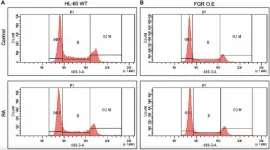(Press-News.org) EMBARGOED UNTIL MONDAY, MARCH 31 – 11:00 AM Eastern
The nuclei in our cells are miniature warehouses safeguarding the genetic blueprint for the body’s biologic machinery.
As warehouses go, nuclei are more like libraries than bank vaults. Too many cellular components need access to the genome to lock it down like Fort Knox. Instead, large groupings of more than 1,000 individual protein molecules called nuclear pore complexes (NPCs) pepper the dividing membrane, serving as gateways for materials and messages entering and exiting the nucleus.
While the basic need for this shuttle service is constant, scientists have shown that cells dynamically adjust their amounts of NPCs like a retail store opening more or fewer checkout lines throughout the day. These fluctuations in genome access points have been observed in different cell types, stages of development, environmental conditions and in diseases such as neurodegeneration and cancer.
“As important as NPCs are for sustaining healthy cells, and despite the connections we and others have found to disease, we still have a lot to learn about how cells control the production of these genome gateways,” said Maximiliano D’Angelo, PhD, associate professor in the Cancer Metabolism and Microenvironment Program at Sanford Burnham Prebys.
D'Angelo and his research team at Sanford Burnham Prebys published findings March 31, 2025, in Cell Reports revealing the results of screening the entire human genome to find factors influencing how many NPCs are assembled.
“Our goal was to identify the modulators of pore formation,” said Stephen Sakuma, PhD, postdoctoral researcher at the Salk Institute, former graduate student in the D’Angelo lab and lead author of the study. “By discovering the mechanisms cells use to modulate pore formation, we may find new therapeutic approaches."
The research team found that the most influential players in the process were parts of opposing teams: the production crew making new proteins and the janitorial staff that recycle proteins and dispose of excess or misshapen proteins.
“It caught our eye that top regulators were pieces of the protein translation or degradation machinery,” said D’Angelo, senior and corresponding author of the study. “While it may seem intuitive because these processes would affect the number of nucleoporin proteins used to construct pores, this had not previously been investigated.”
The scientists also uncovered the role of cellular actors involved in maintaining the messenger RNA (mRNA) that carries codes for building proteins out of the nucleus. The investigators detailed the involvement of a grouping of proteins called the CCR4-NOT complex, which is responsible for triggering the disposal of mRNA.
“We found that this complex reduces the mRNA levels, which diminishes the translation of NPC building blocks,” said Sakuma. “This means it is possible to regulate the number of NPCs in different ways by altering protein translation or degradation, or by stabilizing or destabilizing mRNAs.”
In addition to learning more about these top regulators, the researchers also are studying other factors identified in the genome-wide screen that may be employed to fine-tune levels of NPCs, as well as searching for small molecules that can manipulate NPCs.
With additional research, D’Angelo and his team aim to find ways to reduce NPCs in recklessly growing cancer cells to stop or delay disease progression.
“Our previous work discovered that reducing the number of NPCs is a promising strategy for cancer treatments and we are now developing methods to do that,” said D’Angelo. The group is also working to increase NPC function in brain cells afflicted with neurodegenerative diseases such as dementia.
Additional authors include:
Marcela Raices, Dana Mamriev, Charles I. Fisher and Susanne Heynen-Genel, from Sanford Burnham Prebys
Ethan Y.S. Zhu, from the New York University Grossman School of Medicine
The study was supported by the National Institutes of Health, the National Cancer Institute and the American Cancer Society.
The study’s DOI is 10.1016/j.celrep.2025.115468.
END
Delicate balancing act determines how many genome gateways form in cells
Study finds that protein creation and disposal systems control the amount of nuclear pore complexes in cells, which may lead to new insights about cancer and neurodegeneration
2025-03-31
ELSE PRESS RELEASES FROM THIS DATE:
Postpartum hormonal contraceptive use and risk of depression
2025-03-31
About The Study: Hormonal contraceptive initiation postpartum was associated with an instantaneous increased risk of developing depression in this cohort study. The associated risk was higher the earlier it was initiated postpartum, at least for combined oral contraceptives. This finding raises the issue of whether the incidence of depression postpartum is increased by routine hormonal contraceptive initiation after childbirth.
Corresponding Author: To contact the corresponding author, Vibe Gedsø Frokjaer, PhD, email vibe.frokjaer@nru.dk.
To access the embargoed study: Visit our For The Media website at this link https://media.jamanetwork.com/
(doi:10.1001/jamanetworkopen.2025.2474)
Editor’s ...
CU research poised to change oxygen standards for trauma patients
2025-03-31
When a critically injured patient is admitted to the hospital, how much supplemental oxygen should they receive? New research published this week in JAMA Network Open led by investigators at the University of Colorado School of Medicine suggests it’s often less than the current standard.
“The idea has traditionally been that severe trauma causes stress to patients’ bodies, and we want to deliver as much oxygen as possible to the brain and to vital organs because they are losing blood,” says Adit Ginde, MD, MPH, professor ...
Brain-to-voice neuroprosthesis restores naturalistic speech
2025-03-31
Marking a breakthrough in the field of brain-computer interfaces (BCIs), a team of researchers from UC Berkeley and UC San Francisco has unlocked a way to restore naturalistic speech for people with severe paralysis.
This work solves the long-standing challenge of latency in speech neuroprostheses, the time lag between when a subject attempts to speak and when sound is produced. Using recent advances in artificial intelligence-based modeling, the researchers developed a streaming method that synthesizes brain ...
NCSA research offers new diagnostic tool for anxiety, major depressive disorder
2025-03-31
Scientists at the National Center for Supercomputing Applications and the University of Illinois College of Medicine Peoria (UICOMP) were authors of a research paper published in the Journal of Acoustical Society of America Express Letters that demonstrates improved, automated screening methods for anxiety and major depressive disorders.
In the project titled, “Automated acoustic voice screening techniques for comorbid depression and anxiety disorders,” Mary Pietrowicz, along with colleagues from the University of Illinois Urbana-Champaign and UICOMP, explored how machine ...
Single protein mimics retinoic acid therapy to help leukemia cells mature
2025-03-31
“This study reveals that the expression of the Src-family kinase (SFK), FGR, alone can induce cell differentiation similar to RA.”
BUFFALO, NY – March 31, 2025 – A new research paper was published in Oncotarget, Volume 16, on March 21, 2025, titled “FGR Src family kinase causes signaling and phenotypic shift mimicking retinoic acid-induced differentiation of leukemic cells.”
A research team led by first author Noor Kazim and corresponding author Andrew Yen from Cornell University discovered that the FGR protein—traditionally ...
Research: Top scientists issue urgent warning on fossil fuels
2025-03-31
WASHINGTON— In a review published today in the peer-reviewed journal Oxford Open Climate Change, top scientists issued an urgent warning that fossil fuels and the fossil fuel industry are driving interlinked crises that threaten people, wildlife, and a livable future.
Today’s review synthesizes the extensive scientific evidence showing that fossil fuels and the fossil fuel industry are fueling not only the climate crisis but also public health harms, environmental injustice, biodiversity loss, and the plastics ...
Thinner Arctic sea ice may affect the AMOC
2025-03-31
One of the ocean currents in the Arctic Ocean is at risk of disappearing this century because of climate change, according to a new joint study from the University of Gothenburg and the German Alfred Wegener Institute. As a result, the North Atlantic could be flooded with freshwater which would weaken the global ocean circulation.
The weakening of the AMOC, Atlantic Meridional Overturning Circulation, is a hot topic among the world's climate scientists. However, it is unclear what the consequences will be when ...
How dreams, novelty, and emotions can shape memories: lessons from smartphone studies
2025-03-31
BOSTON - March 31, 2025 - A memory is not a straight line from one point to another, even if we sometimes think of them like linear stories. This key insight that cognitive neuroscientists have known for many years is now guiding a new type of research—to explore not only how memories evolve over time but also how they can be strengthened or changed. Assisting researchers with this new exploration is a powerful tool: smartphones.
“Smartphones are an incredible tool for understanding patterns of feelings, behavior, ...
Leveraging Preexisting Cardiovascular Data to Improve the Detection and Treatment of Hypertension
2025-03-31
About The Study: In the NOTIFY-LVH randomized clinical trial, a centralized population health coordinator–led notification and clinical support pathway for individuals with left ventricular hypertrophy on prior echocardiograms increased the initial treatment of hypertension. This work highlights the potential benefit of leveraging preexisting but potentially underutilized cardiovascular data to improve health care delivery through mechanisms augmenting the traditional ambulatory care system.
Corresponding Author: To contact the corresponding author, Jason H. Wasfy, MD, MPhil, email jwasfy@mgh.harvard.edu.
To access the embargoed study: Visit ...
Study highlights barriers to including non-English speakers in research
2025-03-31
Health researchers omit including speakers of languages other than English (LOE) in their studies due to lack of training, challenges securing interpreter services, budget constraints and other barriers, according to a new JAMA Network Open study.
“Non-English-speaking individuals are being excluded from research, and we wanted to understand why,” said senior author Maya Ragavan, M.D., M.P.H., M.S., associate professor of pediatrics at the University of Pittsburgh. “Ensuring that everyone can participate in research, regardless of the languages that they speak, helps ensure that the findings are representative of the entire community, ...
LAST 30 PRESS RELEASES:
Making lighter work of calculating fluid and heat flow
Normalizing blood sugar can halve heart attack risk
Lowering blood sugar cuts heart attack risk in people with prediabetes
Study links genetic variants to risk of blinding eye disease in premature infants
Non-opioid ‘pain sponge’ therapy halts cartilage degeneration and relieves chronic pain
AI can pick up cultural values by mimicking how kids learn
China’s ecological redlines offer fast track to 30 x 30 global conservation goal
Invisible indoor threats: emerging household contaminants and their growing risks to human health
Adding antibody treatment to chemo boosts outcomes for children with rare cancer
Germline pathogenic variants among women without a history of breast cancer
Tanning beds triple melanoma risk, potentially causing broad DNA damage
Unique bond identified as key to viral infection speed
Indoor tanning makes youthful skin much older on a genetic level
Mouse model sheds new light on the causes and potential solutions to human GI problems linked to muscular dystrophy
The Journal of Nuclear Medicine ahead-of-print tip sheet: December 12, 2025
Smarter tools for peering into the microscopic world
Applications open for funding to conduct research in the Kinsey Institute archives
Global measure underestimates the severity of food insecurity
Child survivors of critical illness are missing out on timely follow up care
Risk-based vs annual breast cancer screening / the WISDOM randomized clinical trial
University of Toronto launches Electric Vehicle Innovation Ontario to accelerate advanced EV technologies and build Canada’s innovation advantage
Early relapse predicts poor outcomes in aggressive blood cancer
American College of Lifestyle Medicine applauds two CMS models aligned with lifestyle medicine practice and reimbursement
Clinical trial finds cannabis use not a barrier to quitting nicotine vaping
Supplemental nutrition assistance program policies and food insecurity
Switching immune cells to “night mode” could limit damage after a heart attack, study suggests
URI-based Global RIghts Project report spotlights continued troubling trends in worldwide inhumane treatment
Neutrophils are less aggressive at night, explaining why nighttime heart attacks cause less damage than daytime events
Menopausal hormone therapy may not pose breast cancer risk for women with BRCA mutations
Mobile health tool may improve quality of life for adolescent and young adult breast cancer survivors
[Press-News.org] Delicate balancing act determines how many genome gateways form in cellsStudy finds that protein creation and disposal systems control the amount of nuclear pore complexes in cells, which may lead to new insights about cancer and neurodegeneration



